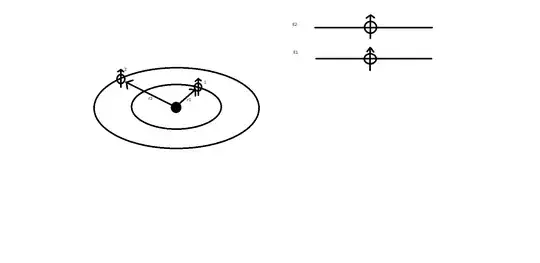I don't quite understand how the exchange of two indistinguishable particles works. In the image I imagine I have two fermions of spin 1/2 in a kind of Hydrogen atom with two discrete energy levels, $E_1$ and $E_2$. The fermions are non-interacting so the total Hamiltonian is given by the sum of the individual Hamiltonians: $H=H_1+H_2$ and the total eigenfunction is given by $\psi_{\alpha}(\vec{r})=\psi_{\alpha_1}(\vec{r_1})\psi_{\alpha_2}(\vec{r_2})$ where $\alpha_1$ and $\alpha_2$ are the set of quantum numbers of particles $1$ and $2$. From what I know from theory, in the case where the eigenfunction is of the type $\psi_{\alpha}(\vec{r})=\psi_{\alpha_1}(\vec{r_1})\psi_{\alpha_2}(\vec{r_2})$ exchanging two particles means exchanging the set of quantum numbers i.e., if $\hat{C}$ is the exchange operator I have: $\hat{C}\psi_{\alpha_1}(\vec{r_1})\psi_{\alpha_2}(\vec{r_2})=\psi_{\alpha_2}(\vec{r_1})\psi_{\alpha_1}(\vec{r_2})$
Now comes the question:
with reference to my image where the two arrows above the fermions indicate the component along the z-axis of the single particle spin, if I swap the two particles, and from the above this means swapping the two quantum numbers, what do I get? Does it make sense to swap these two identical fermions? I understand that mathematically I get a new eigenfunction using the exchange operator $\hat{C}$ but physically don't I get the same situation as before? That is, a fermion in the $E_1$ level with $S_z=1/2$ and a fermion in the $E_2$ level with $S_z=1/2$? In particular I don't understand what happens when I swap quantum numbers, physically speaking is it like taking one fermion and putting it in place of the other? What does $\vec{r_1}$ mean, is it the coordinate relative to particle $1$? But if the particles are indistinguishable what does it mean to give particle 1 the quantum numbers of particle 2?
